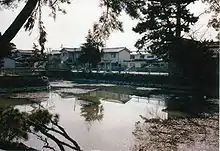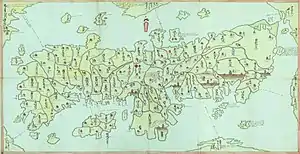Niwase Domain
The Niwase Domain (庭瀬藩, Niwase-han) was a Japanese domain of the Edo period. It was associated with Bitchū Province in modern-day Okayama Prefecture.[1]
| Niwase Domain 庭瀬藩 | |
|---|---|
| Domain of Japan | |
| 1597–1679 1683–1686 1693–1697 1699–1871 | |
| Capital | Niwase jin'ya |
| • Type | Daimyō |
| Historical era | Edo period |
• Established | 1600 |
• Disestablished | 1871 |
| Today part of | Okayama Prefecture |

History
The Niwase domain was founded in 1600, when Togawa Michiyasu, a retainer of Ukita Hideie, rebelled against his lord and sided with the Tokugawa clan at the Battle of Sekigahara. As a reward, the Tokugawa granted Togawa a 29,000 koku fief centered at Niwase Castle. Between the 2nd and fourth generations, parts of the territory were handed out to Michiyasu's various brothers, leaving Niwase with 20,000 koku by the tenure of the 4th generation lord, Yasukaze. Yasukaze died without an heir, and the Togawa family came to an end, with the domain confiscated by the shogunate. In 1683, the Kuze family was transferred to Niwase from Sekiyado, its landholdings were 50,000 koku. The Kuze were there for only one generation, under Kuze Shigeyuki, before being transferred to the Tanba-Kameyama Domain. Matsudaira Nobumichi became the next lord of Niwase, with a 30,000 koku territory; however, he too was transferred, after only 4 years, to the Kaminoyama Domain in Dewa Province.
In 1699, Itakura Shigetaka was transferred into Niwase, with a landholding of 20,000 koku. The domain remained under Itakura rule from then until the Meiji Restoration. The domain school, the Sei'ikan (誠意館), was founded in 1818.
With the end of the han system in 1871, the domain was disbanded, and eventually incorporated into Okayama Prefecture, within which its territory remains to the present day. The Itakura family became viscounts (shishaku 子爵) in the new kazoku nobility system. One notable native of the Niwase Domain was the assassinated prime minister Inukai Tsuyoshi.
List of daimyōs
The hereditary daimyōs were head of the clan and head of the domain.
- Togawa Satoyasu[2]
- Michiyasu
- Masayasu
- Yasunobu
- Yasukaze
- Kuze clan, 1683–1686 (fudai; 50,000 koku)[3]
- Shigeyuki
- Matsudaira (Fujii) clan, 1693–1697 (fudai; 30,000 koku)[1]
- Nobumichi
- Itakura clan, 1699–1871 (fudai; 20,000 koku)[4]
- Shigetaka
- Masanobu
- Katsuoki
- Katsuyuki
- Katsuyasu
- Katsumoto
- Katsusuke
- Katsusada
- Katsushige
- Katsumasa
- Katsuhiro
See also
- List of Han
- Abolition of the han system
References

- "Bitchū Province" at JapaneseCastleExplorer.com; retrieved 2013-4-27.
- Papinot, Jacques Edmond Joseph. (1906). Dictionnaire d’histoire et de géographie du Japon; Papinot, (2003). "Togawa" at Nobiliare du Japon, p. 61; retrieved 2013-5-3.
- Papinot, (2003). "Kuze" at Nobiliare du Japon, pp. 26–27; retrieved 2013-5-3.
- Papinot, (2003). "Itakura" at Nobiliare du Japon, pp. 16–17; retrieved 2013-5-3.
External links
- "Niwase" at Edo 300 (in Japanese)